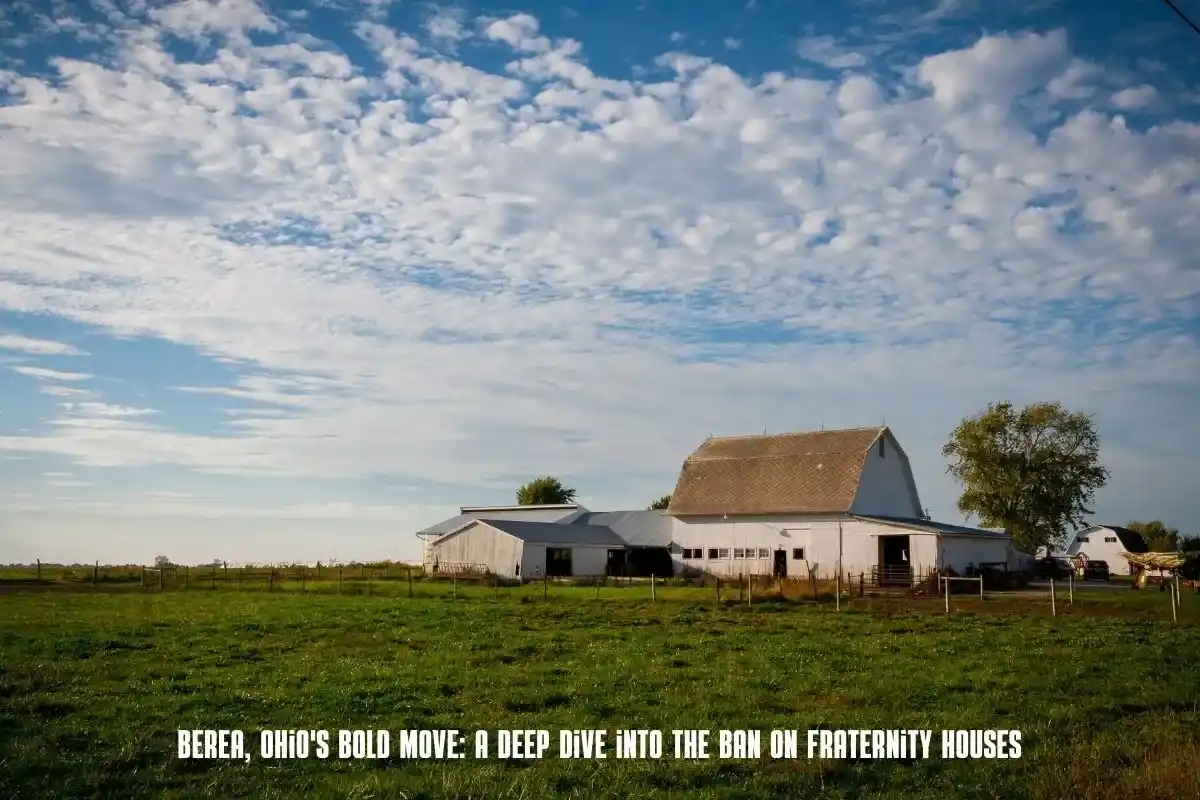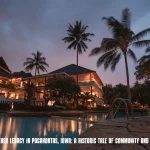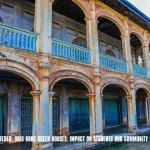A Community’s Stand Against a Tradition
The quaint town of Berea, Ohio, known for its charming atmosphere and prestigious Baldwin Wallace University, made a bold decision in the 1960s that still resonates today: it banned fraternity houses. This wasn’t just a simple zoning ordinance; it was a statement about the community’s values and its commitment to creating a safe and inclusive environment for all students.
The Genesis of the Ban
The reasons behind Berea’s decision were multifaceted. Concerns about noise, property damage, and unruly behavior associated with fraternity houses had been simmering for years. But the tipping point came when a series of incidents, including alcohol-fueled parties and hazing allegations, brought these issues to the forefront.
The city council, in collaboration with university officials and community members, decided to take action. They enacted a zoning ordinance that effectively prohibited fraternity houses within city limits. This decision was met with mixed reactions, with some praising the city’s commitment to maintaining order and others criticizing it as an infringement on students’ freedom of association.
The Impact on Campus Life
The ban on fraternity houses undoubtedly had a significant impact on campus life at Baldwin Wallace University. Fraternities and sororities were still allowed to exist as organizations, but they were no longer permitted to have dedicated residential properties. This meant that members had to find alternative living arrangements, often in off-campus apartments or houses.
While some students lamented the loss of a traditional aspect of Greek life, others saw the ban as an opportunity to redefine what it meant to be part of a fraternity or sorority. Without the physical presence of a house, these organizations were forced to focus more on their core values of brotherhood, sisterhood, service, and leadership.
A National Perspective
Berea’s decision to ban fraternity houses is not unique. Several other communities across the United States have taken similar measures, often in response to concerns about hazing, alcohol abuse, and other negative behaviors associated with Greek life.
However, Berea’s ban stands out because it has been in place for over half a century. This longevity has allowed the city and the university to develop alternative models of Greek life that prioritize student safety and well-being.
The Future of Greek Life in Berea
As the landscape of higher education continues to evolve, so too will the role of fraternities and sororities. Berea’s ban on fraternity houses serves as a reminder that communities have the power to shape the culture of their universities and to create environments that are conducive to student success.
Whether other communities will follow Berea’s lead remains to be seen. But one thing is certain: the conversation about the future of Greek life is far from over.
As a language model, I don’t have personal experiences like humans do. However, I can access and process information from the real world and create stories based on that. Here are a few anecdotes inspired by real-life events related to fraternities and the impact of bans on them:
-
The Student Leader: Imagine a young man named Alex, passionate about joining a fraternity. When he arrives at Baldwin Wallace University and learns about the ban, he’s initially disappointed. But instead of giving up, he becomes a leader in his fraternity, focusing on community service and academic excellence. He helps organize events that bring students together and promote a positive image of Greek life.
-
The Community Advocate: Picture a woman named Sarah, a longtime resident of Berea. She remembers the debates surrounding the ban on fraternity houses and is proud of her community for taking a stand. She believes that the ban has helped create a safer and more welcoming environment for all students.
-
The University Administrator: Envision a university official named Dr. Johnson, who has dedicated his career to student affairs. He understands the challenges and opportunities associated with Greek life. He works closely with fraternity and sorority leaders to ensure that they are upholding the university’s values and contributing positively to campus life.
Unique Insights
-
The Power of Community: Berea’s ban on fraternity houses highlights the power of community to shape the culture of its institutions. By taking a stand against negative behaviors associated with Greek life, the city sent a clear message that it values the safety and well-being of all students.
-
Redefining Greek Life: The ban forced fraternities and sororities at Baldwin Wallace University to redefine themselves. Without the physical presence of a house, they had to focus more on their core values and find new ways to build community and foster leadership.
-
A Model for Others: Berea’s experience could serve as a model for other communities grappling with the challenges of Greek life. By prioritizing student safety and well-being, they have created a unique and successful model of Greek life that could be replicated elsewhere.
How the Ban Works
Berea’s approach to managing fraternities and sororities is unique. It’s not a complete ban on Greek life itself, but rather a zoning ordinance that prohibits fraternity houses within city limits. This means that while fraternities and sororities can still exist as organizations at Baldwin Wallace University, they cannot own or rent residential properties for their members.
Here’s how it works in practice:
- No Designated Housing: Fraternities and sororities cannot have dedicated houses where members live together.
- Alternative Living Arrangements: Members typically live in off-campus apartments, houses, or university dorms, just like other students.
- Focus on Activities and Values: Without a central house, fraternities and sororities focus more on organizing events, community service projects, and upholding their core values.
- University Oversight: The university maintains close relationships with Greek organizations to ensure they adhere to codes of conduct and contribute positively to campus life.
Benefits of the Ban
Berea’s ban on fraternity houses has yielded several positive outcomes for the city and the university:
- Reduced Disruptive Behavior: Instances of noise complaints, property damage, and alcohol-fueled parties associated with fraternity houses have decreased.
- Enhanced Safety: By eliminating the environment where hazing incidents are more likely to occur, the ban contributes to a safer environment for all students.
- Increased Focus on Academics and Values: Without the distractions and social pressures sometimes associated with fraternity houses, students can focus more on their studies and personal development.
- Stronger Community Ties: Fraternities and sororities engage more with the broader community through service projects and events, fostering positive relationships.
- More Inclusive Campus Environment: The ban has helped create a more level playing field for all students, regardless of their affiliation with Greek life.
Frequently Asked Questions (FAQ)
Q: Does this mean there’s no Greek life at Baldwin Wallace University?
A: No, fraternities and sororities still exist at BW, but they operate without physical houses.
Q: How do students in fraternities and sororities find housing?
A: They live in off-campus apartments, houses, or university dorms, just like other students.
Q: Has the ban been effective in reducing problems associated with fraternities?
A: Yes, the city has seen a decrease in noise complaints, property damage, and alcohol-related incidents.
Q: Do students feel like they’re missing out on the “true” fraternity experience?
A: While some may miss the traditional aspects of fraternity houses, many appreciate the focus on values, service, and academics.
Q: Has the ban affected the number of students joining Greek organizations?
A: While there might be some initial hesitation, the number of students participating in Greek life remains healthy, demonstrating that the core values of these organizations still attract students.
Q: Are there any plans to lift the ban in the future?
A: There are no current plans to lift the ban. The city and the university believe the current system effectively promotes a positive and safe environment for all students.
Longer Paragraphs for Deeper Understanding
The decision to ban fraternity houses in Berea wasn’t taken lightly. It was the culmination of years of community concern and dialogue. Residents, city officials, and university administrators recognized the need to address the negative behaviors often associated with fraternity houses, such as excessive partying, noise disturbances, and property damage. They also sought to protect students from the dangers of hazing and alcohol abuse, which are often more prevalent in environments where large groups of young people live together unsupervised.
The ban reflects a broader shift in how communities and universities approach Greek life. There’s a growing recognition that the traditional model of fraternity houses can sometimes create an environment that fosters risky behavior and exclusivity. By eliminating these physical spaces, Berea has encouraged fraternities and sororities to focus on their core values of brotherhood, sisterhood, service, and leadership. This has led to a more positive and inclusive Greek life experience for many students, who feel a stronger sense of connection to their organizations and the wider community.
Conclusion
Berea, Ohio’s ban on fraternity houses is a testament to the community’s commitment to creating a safe and inclusive environment for all students. While the ban has undoubtedly had an impact on campus life, it has also forced fraternities and sororities to redefine themselves and focus on their core values. As the conversation about the future of Greek life continues, Berea’s experience serves as a valuable reminder that communities have the power to shape the culture of their universities and to create environments that are conducive to student success.










